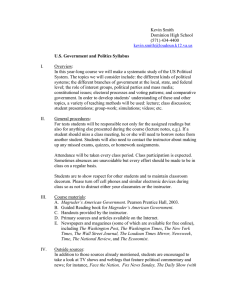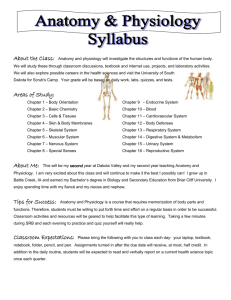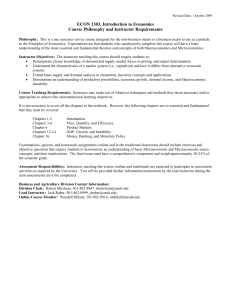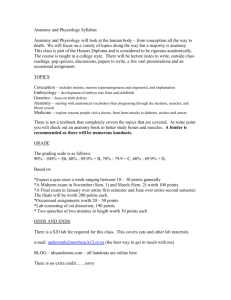Class Syllabus - UM Personal World Wide Web Server
advertisement
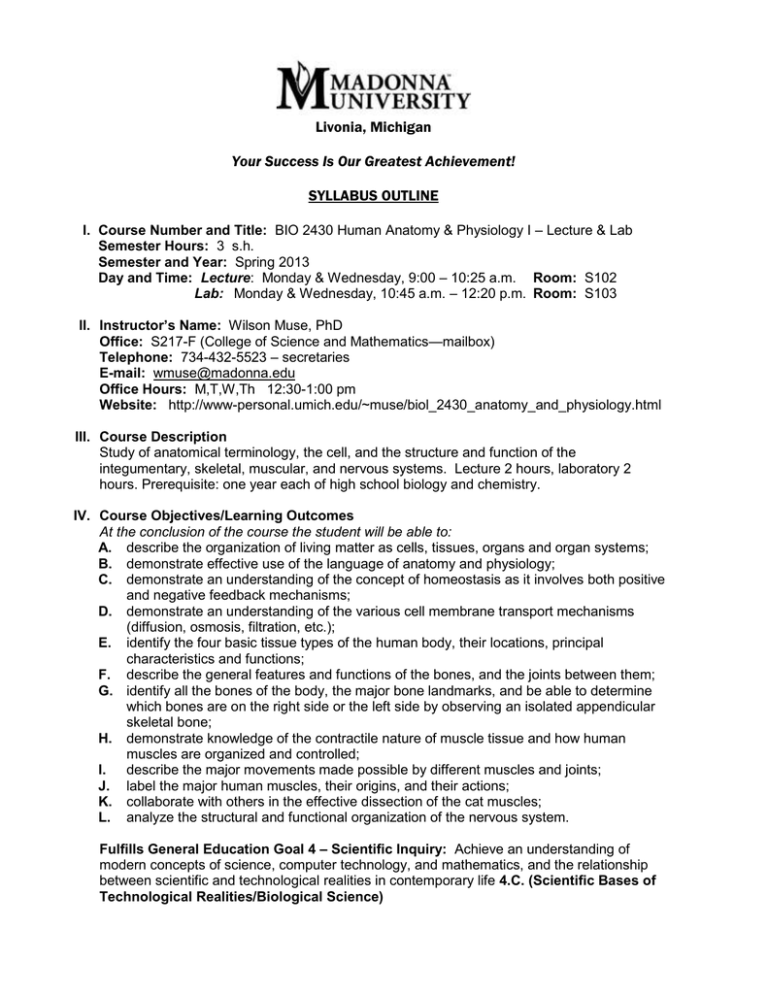
Livonia, Michigan Your Success Is Our Greatest Achievement! SYLLABUS OUTLINE I. Course Number and Title: BIO 2430 Human Anatomy & Physiology I – Lecture & Lab Semester Hours: 3 s.h. Semester and Year: Spring 2013 Day and Time: Lecture: Monday & Wednesday, 9:00 – 10:25 a.m. Room: S102 Lab: Monday & Wednesday, 10:45 a.m. – 12:20 p.m. Room: S103 II. Instructor’s Name: Wilson Muse, PhD Office: S217-F (College of Science and Mathematics—mailbox) Telephone: 734-432-5523 – secretaries E-mail: wmuse@madonna.edu Office Hours: M,T,W,Th 12:30-1:00 pm Website: http://www-personal.umich.edu/~muse/biol_2430_anatomy_and_physiology.html III. Course Description Study of anatomical terminology, the cell, and the structure and function of the integumentary, skeletal, muscular, and nervous systems. Lecture 2 hours, laboratory 2 hours. Prerequisite: one year each of high school biology and chemistry. IV. Course Objectives/Learning Outcomes At the conclusion of the course the student will be able to: A. describe the organization of living matter as cells, tissues, organs and organ systems; B. demonstrate effective use of the language of anatomy and physiology; C. demonstrate an understanding of the concept of homeostasis as it involves both positive and negative feedback mechanisms; D. demonstrate an understanding of the various cell membrane transport mechanisms (diffusion, osmosis, filtration, etc.); E. identify the four basic tissue types of the human body, their locations, principal characteristics and functions; F. describe the general features and functions of the bones, and the joints between them; G. identify all the bones of the body, the major bone landmarks, and be able to determine which bones are on the right side or the left side by observing an isolated appendicular skeletal bone; H. demonstrate knowledge of the contractile nature of muscle tissue and how human muscles are organized and controlled; I. describe the major movements made possible by different muscles and joints; J. label the major human muscles, their origins, and their actions; K. collaborate with others in the effective dissection of the cat muscles; L. analyze the structural and functional organization of the nervous system. Fulfills General Education Goal 4 – Scientific Inquiry: Achieve an understanding of modern concepts of science, computer technology, and mathematics, and the relationship between scientific and technological realities in contemporary life 4.C. (Scientific Bases of Technological Realities/Biological Science) V. Required Texts Text: Martini and Nath, Fundamentals of Anatomy and Physiology. 2012 (9th Ed) 3-hole punch. ISBN-13: 9780321737458 Lab Manual: Human Anatomy and Physiology Laboratory Manual - Cat Version by Marieb. 2012 (10th edition). ISBN-13: 9780321765581 Optional materials are in the bookstore, and other materials can be special ordered from Bookstore if not on shelf. Before purchasing additional materials, check the website “Get SmartBody.com” - there is a lot of free info on this website!! Also try - http://groups.msn.com/anatomyphysiologytests - check this one first!! Class website also has links and study guides: http://www-personal.umich.edu/~muse/biol_2430_anatomy_and_physiology.html VI. Time Commitment Expected per Semester-Hour Credit Earning one semester hour of undergraduate credit requires a minimum of one hour of classroom or direct instruction each week for a full semester and a minimum of two hours of out-of-class student work each week for a semester, or its equivalent. An equivalent amount of work (minimum three hours per week for a semester, or its equivalent of combined direct instruction and outside-of-class student work) is used as the measurement for a credit hour in other credit-bearing activities, such as laboratory experiences, service-learning, internships, practica, clinicals, studio work, and other academic experiences. VII. Attendance Policy Attendance in lab is essential and expected in lecture. In accordance with Madonna University policy, students are required to attend all classes. Only excused absences with a doctor or hospital note, accident report, written excuse from employer for out-of-town assignment, or death in family can exempt a student from attendance. Extended absences, whether excused or not, are to be reported to the Office of Student Life (734) 432-5428, and students will be strongly encouraged to consider withdrawal, in order to avoid failure in the course. Note: An absence for any reason does not excuse a student from knowing and applying the objectives of any given course activity. Extra Credit: NONE: There is no provision in this course for improving a grade by extra work. VIII. Grading Computation A. Requirements for obtaining a grade of “D” or higher (1) Completion of the Final Exam (2) Attainment of at least 600 of a possible 1000 points B. Grading Scale: A = 900-1000 A– = 880-899 B+ = 850-879 B = 800-849 B– = 780-799 C+ = 740-779 C = 680-739 D = 600-679 F = 000-599 * Anyone not officially withdrawing from the course by the university deadline will receive the grade of “F”, if deserving. Forms are available from the Registrar. ** Incompletes (I) are rarely given and are awarded at the discretion of the instructor. -2- C. Point Distribution: (a) Lecture Exams (3 @100pts.) (b) Lecture Final Exam (Cumulative) (c) Online homework (c) = 300 = 100 = 200 600 Laboratory Tests and Quizzes Quiz #1 50 Exam #1 100 Exam #2 100 Quiz #2 50 Exam #3 100 Sub-total Lab = 400 Class Total Points = 1000 IX. Student Evaluation of Faculty Instruction (SEFI) Students are invited to evaluate every course every semester, utilizing the University's online Student Evaluation of Faculty Instruction (SEFI) system. This is accessed from the opening page of the University's Website from the "Quick Links" drop-down box or by following link: https://ww4.madonna.edu/mucfweb/ssl_forms/student_opin/StudentGUI/login.cfm Your instructor will inform you when during the semester the SEFI can be accessed. X. Emergency Continuation of Instruction: In the event of a city-wide or regional crisis or emergency that prevents students from traveling to campus (such as a flu epidemic), course instruction will be continued on the class's Blackboard site, provided that campus technology and electricity are operating. If campus facilities, technology, and electricity are not operational, students should continue doing their reading and assignments until they receive communication from the instructor or the University. XI. Assignments and Miscellaneous Information PERSONAL NOTE TO STUDENTS Be aware that BIO 2430 is a content-intensive course intended to help you develop into a competent professional. My challenge is to get you to be the very best that you can be. Therefore, my exams are thorough and challenging without being impossible. I have high expectations that will determine certain limitations for you. Hopefully you will grow academically from your classroom experiences by viewing each exam as a tool for learning. Look upon this course as a journey over and through the human body. You must be able to develop mental pictures of what is being described. My role is to lead you on this journey with accuracy and precision at a rather fast pace. You do not want to fall behind. Develop a schedule that actually works for your particular situation, and do not be afraid to modify it accordingly. Realize that we can only be successful on this journey by your active participation and by the cooperation of your loved ones. Tell them that you are going to be quite busy for the next 12 weeks. Develop effective and efficient study techniques. Your efforts should then be rewarded by “pride in accomplishment”. Tardiness is not acceptable. Class begins promptly. You should be in your seat with your notes and other materials ready at that time. Students who enter the room after class has already begun are distracting to me and to the other students in the class who are prepared and on time. -3- Do not talk with your neighbor while I am lecturing. There will be time for discussion with classmates on various topics, but not while I am speaking. The noise is distracting to me and to other students in the class. If you have a question about the lecture material, please raise your hand and ask me directly. I strongly encourage you to ask questions, since this is the only way for me to learn if students need additional explanations or information. If you carry a personal phone or beeper, please turn it off during class. Do not be afraid to ask questions!!!!! Suggestions – You may find it advantageous to: (1) bring the text to lecture, (2) bring the text and lab manual to lab, (3) see the instructor about any problems which affect your grade (missing tests, study problems, illness, deaths in family, etc.), (4) use the books in the bookcase in the lab, (5) tape the lectures, make up missed work as soon as possible, (6) see the instructor during office hours or prearranged times for asking questions, etc., (7) review the chapter objectives, summary and review questions, (8) complete the Review Sheets in the lab manual (at the end of each Exercise) (9) check out books from the library, (10) obtain a tutor through the Center for Personal Instruction (CPI) in Room 1400, phone: (734-432-5599), (11) keep your own updated record of your scores, (12) write your name in your book and (13) study at least one hour each day, (14) review the CD programs that accompany your test and lab manual. LABORATORY INFORMATION If you cannot attend your regular lab session, please attend another lab session and let the instructor know you are not enrolled in their lab. Laboratory Safety A copy of “Science & Safety, Making the Connection” (guidelines for classroom safety identified by the council of State Science Supervisors) can be found in the laboratory. The guidelines can also be accessed at www.csss-science.org/downloads/scisafe.pdf You should familiarize yourself with the location and use of the safety facilities available in the lab. The safety facilities include the First Aid Kit, safety eyewash, fire extinguisher, telephone, and fire exits. Please read the inside front cover of your lab manual, which lists 16 A&P Lab Safety Guidelines. GLOVES (latex or vinyl) ARE ALWAYS WORN WHEN DEALING WITH ANY BODY FLUIDS including helping someone with a cut!! The First Aid Kit is in the drawer next to the door. Latex & vinyl gloves are provided for your use in lab for dissections. Please use the same pair throughout a particular class session (if you leave the room for some reason, plan to reuse your gloves). At the end of a particular session (scheduled lab or open lab), please discard your gloves properly. Laboratory Fee The laboratory fee does not cover in entirety the cost of lab materials and equipment. Should a student break or damage equipment that has a repair or replacement cost of $10 or more, the student will be charged the cost of repair or replacement of damaged equipment. If the person(s) responsible for equipment breakage or damage does not notify the instructor of a breakage or damage situation, all groups using the workstation at the time an instructor determines that there is a problem will be equally assessed the cost of repair or replacement. -4- Laboratory Attendance You are expected to attend all lab sessions - this reduces confusion amongst lab partners, especially when dissections are being conducted. Lab partners will rely upon each other’s assistance during lab. Therefore, lab sessions are not interchangeable. If you miss a lab session, please notify the lab instructor as soon as possible. No food or drink is permitted in classrooms for your health and safety! (The adjacent room is the Microbiology lab and many spores travel between the rooms). Leave food and drink containers in the wastebasket upon entering the lab. Do not leave on the tables or chairs or in the sinkwells. Inclement Weather and School Closings - Announcements will be made on TV and radio stations. Sometimes decisions are made after you leave for classes. Use your own discretion about coming to class - if conditions are dangerous, please do not risk driving to classes. There are no make-up exams. The only possible exceptions are: 1. You are in the hospital. This requires a note from your physician that you were in the hospital on the date of the exam. 2. The death of an immediate family member (spouse, child, sibling, or parent). A death notice is required. The death must have occurred within three days prior to the exam. Tips for Success: Skim through the notes and the corresponding chapter in the text, noting the bolded section headings, so you will have some idea of the topic to be discussed. Attend class regularly, pay attention, and take notes in class. The lecture notes I provide are an outline, and I supplement them with information that is either spoken or written during class. You should be alert and engaged during the lecture so that you can take note of important points that I cover verbally. Ask questions! If you do have a question about a term or a concept, other students may be wondering the same thing. Raise your hand and ask the question as it occurs to you because you are likely to forget if you save it until the end. I strongly encourage you to ask your questions during class, although you are always welcome to e-mail me or come before or stay after class and ask questions then, too. After class, review your notes by reading through them. Next, go to the text and read or re-read the assigned material. This should reinforce the concepts that we have discussed during class. In order to excel at any subject, you must spend some time on it every day! If you save your work for the last minute and don’t regularly read the text or review your notes, you will have a lot of difficulty with this course. Get to know your classmates and form a study group. It is best to study with other students so that you can test one another and discuss key ideas and concepts from class. Students often “fool themselves” into thinking they know the material, only to discover (usually during the first exam) that they didn’t know it very well at all. If study guides are provided - use them! These are generally posted one week prior to the exam. It is important to review the questions on the study guide, as these often show up word-for-word on the exam. Just because a topic isn’t covered on the study guide or practice exam does not mean you don’t have to know it; any material from the lecture or text is fair game for examination questions. The study guide will, however, emphasize the main points and most important concepts, and it is a valuable resource. Log on to the Blackboard course web site frequently for announcements, updates, and other assignments. SI is available for this course – Christina Marchelletta (cmarchelletta@my.madonna.edu ) -5- SIGMA ZETA A National Science and Mathematics Honor Society Madonna University – College of Science and Mathematics is pleased to offer membership in our local chapter of Sigma Zeta to our outstanding science and math majors. Applications for membership are accepted during September and October. Please contact the Science & Math office for information regarding requirements and deadlines. An installation dinner for new members is in November. -6- XII. Course Schedule WEEK 1 2 3 DAY 5 6 LECTURE LABORATORY Terms, Systems (exercises 1 and 2) 5/8 Chapters 1 and 3: Introduction to Anatomy and Physiology Chapter 3: The Cell 5/13 Chapters 4: Tissues 5/15 Chapter 5 Integumentary System 5/20 Chapters 4 and 5: Tissues and Integumentary System Exam #1: Chapters 1, 3, 4, 5 Quiz #1 ( ex 1, 2, 4 – cell organelles only) Mitosis, Histology (ex. # 4,6) Histology-cells, tissues (exer. # 7,8) Histology, Skin, Membranes (exer. # 7,8) Membrane function (exercise 8) Hug a veteran 5/6 5/21 4 We will be closed May 27 and July 4 for holidays 5/29 Memorial day = no class make some vitamin D Chapter 6: Skeletal System 6/3 Chapter 6: Skeletal System 6/5 Chapters 7: Axial Skeleton 6/10 Chapters 8: Appendicular Skeleton 6/12 Chapters 9: Articulations 5/27 Cells (exercise # 4) Exam #1 (exer: 1,2,4,6,7,8) Skeleton - bones (know spellings) (exer. # 9-12) Skeleton – bones cont. Histology of bone Skeleton (axial) - bony parts (exer. 9-12) Skeleton (appendicular)- bony parts (exer. 9-12) Exam #2 (x. 9-12) Practical-Must know bones and spellings 7 8 9 6/17 Exam #2: Chapters 6 - 9 6/19 Chapters 10: Muscle Tissue 6/24 Chapters 10: Muscle Tissue 6/26 Chapters 11: Muscular system 7/1 Chapter 12: Nervous tissue Histology of Muscle (Exercise 14) Muscles - Cat (x. 13,15) (Dissection exercise #1) Muscles - Cat (x. 13,15) cont. (Dissection exercise #1) Muscles - Cat (ex. 15) (Dissection exercise #1) cont. Quiz #2: (ex 15) Muscles – Cat Practical-Must know muscles and spellings 10 11 12 7/3 Chapter 10-12 review catch-up and salvage brain cells 7/8 Exam #3: Chapters 10 - 12 Nervous Tissue (exer. #17) 7/10 Chapter 13: Spinal Cord Brain, cranial nerves (x. 15, 17, 19) 7/15 Chapter 14: Brain and Cranial nerves 7/17 Chapter 15: Somatic Nervous system. Nervous Tissue, Brain (x. 15, 17, 18a, 19) Cranial Nerves and Spinal Cord (ex 21) 7/22 Chapter 16: Autonomic Nervous system Exam #3: (ex. 17, 19, 20, 21) 7/24 FINAL EXAM: Chapters 1-16 pick up lab exams- reflect Check the Madonna website for your grade at the end of the semester. Z:\Academic Administration\Science and Mathematics\SYLLABUS\BIOLOGY (BIO)\S13\2430 Muse Lec Lab S13.docx -7-

